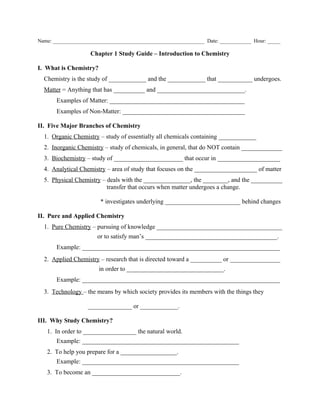
Chapter 1 Notes - Student Handout
- 1. Name: __________________________________________________________ Date: ____________ Hour: _____ Chapter 1 Study Guide – Introduction to Chemistry I. What is Chemistry? Chemistry is the study of ____________ and the ____________ that ___________ undergoes. Matter = Anything that has __________ and ____________________________. Examples of Matter: ___________________________________________ Examples of Non-Matter: _______________________________________ II. Five Major Branches of Chemistry 1. Organic Chemistry – study of essentially all chemicals containing ____________ 2. Inorganic Chemistry – study of chemicals, in general, that do NOT contain _____________ 3. Biochemistry – study of ______________________ that occur in ____________________ 4. Analytical Chemistry – area of study that focuses on the ____________________ of matter 5. Physical Chemistry – deals with the _______________, the ________, and the __________ transfer that occurs when matter undergoes a change. * investigates underlying ________________________ behind changes II. Pure and Applied Chemistry 1. Pure Chemistry – pursuing of knowledge ________________________________________ or to satisfy man’s __________________________________________. Example: _______________________________________________________________ 2. Applied Chemistry – research that is directed toward a __________ or ________________ in order to _______________________________. Example: _______________________________________________________________ 3. Technology – the means by which society provides its members with the things they ______________ or ____________. III. Why Study Chemistry? 1. In order to _________________ the natural world. Example: __________________________________________________ 2. To help you prepare for a __________________. Example: __________________________________________________ 3. To become an ____________________________.
- 2. Example: __________________________________________________ IV. Chemistry Far and Wide 1. Materials – Chemists design materials to fit ______________________ in the world. a. Macroscopic – the world in which objects are _________ enough to _______. b. Microscopic – the world where objects can only be seen under ________________. 2. Energy – Chemists play an essential role in finding ways to _________________, ____________________, and _____________ energy. 3. Medicine – Chemistry supplies the ________________, ________________, and ____________________ that doctors use to treat their patients. - Biotechnology – applies science to produce biological _____________ and _____________ 4. Agriculture – Chemists help develop more _______________ crops and safer, more effective ways to _______________ crops. i. Soil ________________ testing to figure out ways to improve soil ii. Adding ___________________ to the soil iv. Developing __________________ to prevent the growth of weeds. v. Developing __________________ to kill or deter pests. vi. Developing other chemicals to help prevent plant ________________. vii. Biochemists modify the _________ of plants to make them better. 5. The Environment – Chemists identify ________________ and prevent ______________. V. The Scientific Method Def – A ____________, __________________ approach to solving problems. 1. Problem – A ____________ to be answered, usually stated as a _____________. 2. Observations - Using your ____________ to obtain information about the problem. 3. Hypothesis – A ____________________________ for an observation. 4. Experiments – A procedure used to ________ your hypothesis. a. Manipulated or ____________ variable – a variable you _____________ b. Responding or _____________ variable – variable you _______________ 5. Conclusion – _____________ experimental results to form ____________ or ________ a. Theory – a well-tested _______________ for a set of observations. - Tries to ___________________, but can be never be ______________. b. Law – a concise statement that ___________________ results of many observations.
- 3. - A law is simply a statement of ________ that does not try to ______________.
